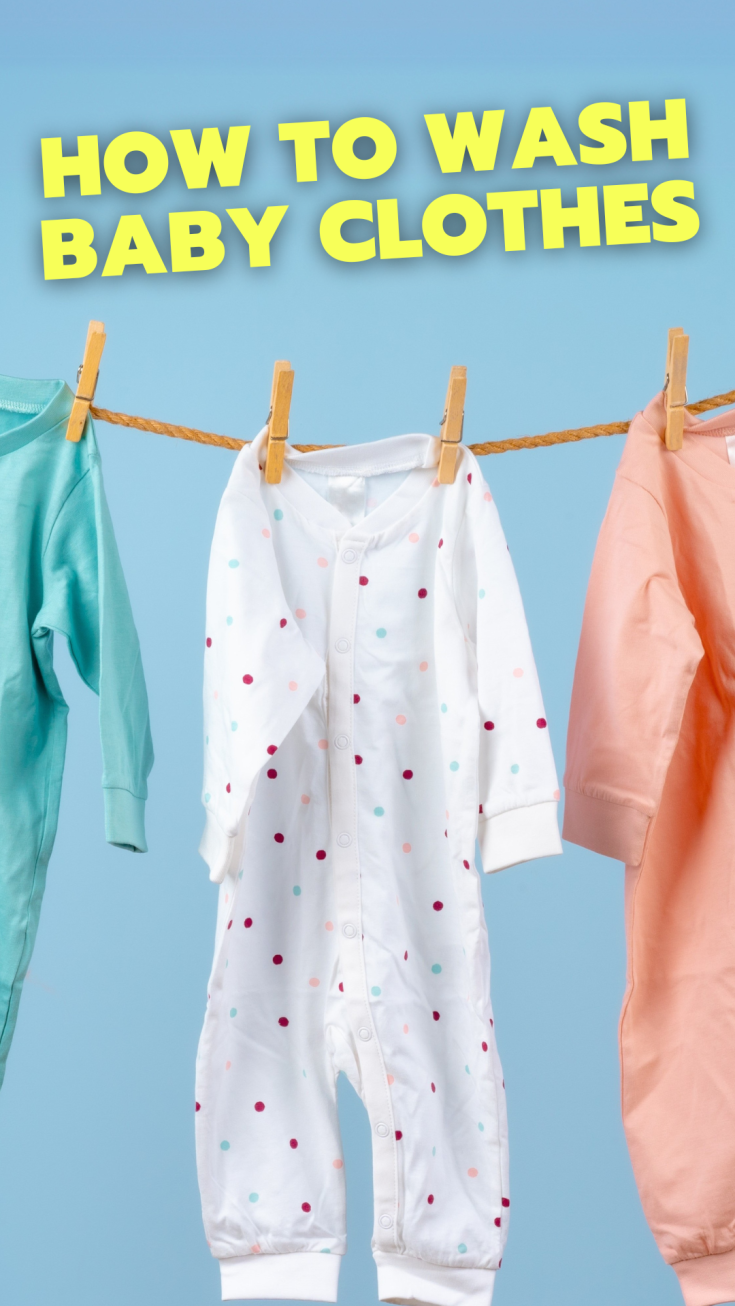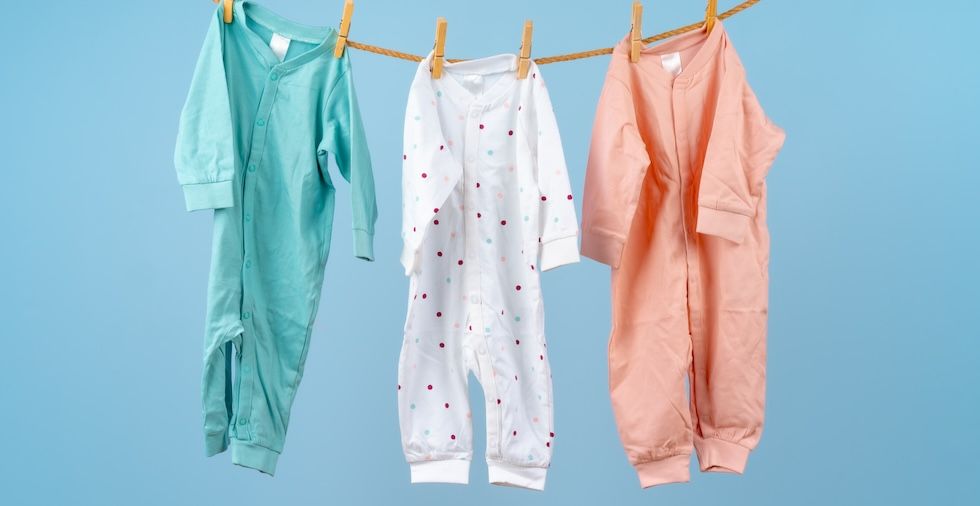- Why is washing baby clothes different?
- How to wash baby clothes (and protect their skin!)
- Bonus: How to wash unique baby clothes
- Extra tips for washing baby clothes
Being a new parent is hard enough, but it can be hard to manage when dealing with the ever-growing pile of laundry. Chances are, nobody ever told you how to wash baby clothes, and you feel like you're out on your own. Luckily, you've come to the right place.
In this guide, we'll walk you through everything you need to know about how to wash baby clothes. We'll cover how to hand wash delicate items, tackle soiled laundry, and care for unique fabrics like wool and bamboo. Let's dive in, shall we?
Why is washing baby clothes different?
First, let's talk about why this is different from other clothing. Unlike adult clothing, baby clothes require extra care. Babies' sensitive skin is more prone to irritation, so you must choose gentle detergents and avoid harsh chemicals.
But it doesn't end there. Baby clothes are often exposed to tougher stains like sick, spit, and even worse. All of these stains need careful handling. If you don't know how to deal with them, they can stick around longer than you might like.
We have the answer. Understanding how and when to wash baby clothes will make laundry day more manageable, leaving you more time to enjoy those precious moments with your little one.
How to wash baby clothes (and protect their skin!)
Now that you understand why this requires a different approach, let's discuss how to do it. Here's a quick step-by-step guide on how to wash baby clothes.
Step 1: Always pre-wash new clothes
Before you get started, you need to know one thing. If you're wondering how to wash newborn baby clothes for the first time, pre-washing is essential. Don't skip this critical step.
Even brand-new clothes can contain dust, residues, or irritants from manufacturing. Use a baby-safe detergent and wash all items before your baby wears them.
Step 2: Sort your baby clothes
Start by separating your baby clothes by colour—light, dark, white, and fabric type. Mixing wool or hand-knitted baby clothes with heavier fabrics can damage them.
While this may be a pain, it's a worthwhile step. You must keep all these items separate when you wash your baby's clothing.
Step 3: Choose a suitable detergent
The detergent you use matters, especially to your baby's skin. This is perhaps the most crucial step of all.
Use a hypoallergenic detergent like Dreft or one specifically designed for babies. When choosing the right detergent for your baby's clothing, always look for the British Skin Foundation logo.
Avoid regular washing powders and fabric softeners, which can leave irritating residues. For extra cleaning power, you can add a sprinkle of baking soda.
Step 4: Pretreat any nasty stains
You know the drill—plenty of things can stain baby clothes. Whenever your baby soils their garments, you must ensure you pretreat those stains.
You can do that by rinsing the area under cold water to remove as much as possible. Next, apply a baby-safe stain remover or baking soda paste before washing.
The more work you can do at this stage, the more likely the stain will come out. For example, you may want to massage the area of the stain to remove it as much as possible.
Step 5: Choose the right temperature
If you're asking how hot to wash baby clothes, the answer depends on the fabric. You should take note of this before choosing the temperature for your cycle.
Most baby clothes can be washed at 30–40°C. However, a warmer temperature may be necessary for heavily soiled items. Avoid high heat to prevent shrinking or fabric damage.
Step 6: Use a gentle cycle
Next, let's discuss which cycle you need to use. It is no surprise that you want to use a gentle cycle here.
Set your washing machine to a gentle or delicate cycle to avoid wear and tear on tiny garments. Handwashing may be safer if the clothes are very fragile or knitted.
Step 7: Dry the clothes naturally
You want your baby's clothes to look new, so you must take extra care when drying them.
Line drying is ideal for baby clothes to maintain their softness and shape. Use a tumble dryer on a low heat setting if you're short on time. Always check the care labels for guidance.
Bonus: How to wash unique baby clothes
Of course, not all baby clothes are created equal. If you have some extra delicate or intricate pieces, you'll want to be careful with them to avoid ruining them.
How to wash hand-knitted baby clothes
Do you have a special garment? Hand-knitted baby clothes often require extra care. You can wash them by hand in lukewarm water with a gentle detergent. Be sure to rinse thoroughly to remove all soap, then lay them flat to dry to prevent stretching.
How to wash woollen baby clothes
Wool baby clothes need special attention. If the items are machine-washable, use a detergent made for wool and select a wool or gentle cycle. Handwashing is often the best method for these garments.
How to wash bamboo baby clothes
Bamboo fabric is naturally soft and hypoallergenic but can also be super delicate. Wash bamboo baby clothes on a gentle cycle with cool water and a baby-safe detergent to maintain its natural properties. Avoid fabric softeners.
How to wash soiled baby clothes
As we've already mentioned, pretreating is critical. For heavily soiled items, rinse the affected area under cold water before treating it with a stain remover. Wash immediately to prevent stains from setting. The sooner you deal with these stains, the better!
How to wash second-hand baby clothes
Second-hand clothes are a great way to save money but need thorough cleaning. You want to ensure they are safe for your baby to wear. Wash them separately with a baby-safe detergent before you use them. Don't assume they are clean when you get them.
Extra tips for washing baby clothes
Looking for some extra advice? We've got you covered. Here are some of the bonus tips you can use when it comes to washing baby clothes:
Use mesh bags for small items
Don't we all want to avoid losing things? To prevent tiny socks and mittens from disappearing in the wash, place them in a mesh laundry bag.
Stick to a solid routine
It can be challenging to stay on top of this task. Set aside a specific day for washing baby clothes to keep on top of the laundry pile.
Don't overload your washing machine
Baby clothes are small, but overloading the machine can lead to less effective cleaning. Don't be tempted to put too many clothes in the machine as it's a mistake.
Ready to get started? Washing baby clothes doesn't have to be complicated. You can confidently handle everything from new outfits to soiled nappies by understanding how to wash baby clothes. Whether pre-washing newborn garments, caring for delicate hand-knitted items, or figuring out the best laundry detergent, these tips will help keep your baby's wardrobe fresh, clean, and skin-safe.
Q&A
Were you looking for some extra advice? If we missed something, check out our frequently asked questions below.
How long do you have to wash baby clothes separately?
Washing baby clothes separately from adult laundry for the first 6–12 months is a good idea. This approach helps avoid exposure to harsh detergents and ensures a gentler wash.
Can you use fabric softener with baby clothes?
If you can avoid it, do so! Skipping fabric softener for baby clothes is best, as it can reduce absorbency and leave behind residues that may irritate sensitive skin.
How early should you wash baby clothes?
Want to know how far in advance to wash baby clothes? Aim to have everything ready around 30–60 days before your baby's arrival. This timeline gives you enough breathing room while ensuring the clothes stay fresh and clean.
How often should you wash baby clothes?
Babies undergo several outfit changes a day, especially during the first few months. Unfortunately, depending on how many items you have and how soiled they get, you might need to wash clothes daily or every other day.
Any questions? Leave a comment below!


Leave a Reply